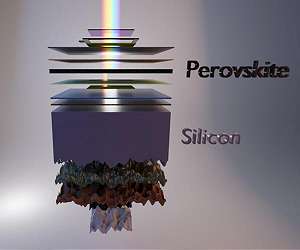A new pathway to creating durable, efficient perovskite photovoltaics at industrial scale has been demonstrated through the first effective use of lead acetate as a precursor in making formamidinium-caesium perovskite solar cells.
Members of Exciton Science, based at Monash University, were able to create perovskite solar cells with 21% efficiency, the best results ever recorded for a device made from a non-halide lead source.
A mini prototype solar panel featuring these cells achieved 18.8% efficiency. The large-area perovskite layer was fabricated in ambient atmosphere and was made via a single-step blade coating, demonstrating its potential viability for industrial-scale manufacturing.
The test devices also showed strong thermal stability, continuing to function with no efficiency loss after 3,300 hours running at 65 C.
First author Jie Zhao, a PhD student at Monash University, said: “We’ve been able to use lead acetate in a one-step, spin-coating process to get the perfect, high-quality formamidinium-caesium perovskite thin film.
“And because we don’t need an anti-solvent agent, we can do this via large-scale techniques, such as blade coating, which means it’s viable at industrial scale.”
The results have been published in the journal Energy and Environmental Science and are available here.
Corresponding author and Monash University colleague Dr Wenxin Mao said: “The vast majority of perovskite solar cell research uses lead halides, particularly lead iodide.
“The lead iodide needs to be 99.99% pure and it’s very expensive to synthesise cells using lead iodide.
“We’re the first group to make highly stable formamidinium-cesium perovskite solar cells using lead acetate rather than lead iodide.
“We have provided the entire research community a second way to make high-quality perovskite solar cells.”
More about perovskites: Promise versus problems
Thin film solar cells made from perovskites have the potential to disrupt the solar energy sector, thanks to their relatively low manufacturing cost, flexibility and tunable band gap relative to silicon.
However, researchers are struggling to solve reliability issues, and they also need to find a way to create devices at a viable commercial scale.
Perovskites are solution processed (made in liquid) using a variety of different ingredients.
Most approaches use lead halides and require the inclusion of strong polar solvents with high boiling points and antisolvent quenching agents to control the perovskite crystallisation process.
This complicated mechanism can lead to defects in the thin films, which causes the resulting device to rapidly lose efficiency. It’s also hard to control.
The chemical compound lead acetate has emerged as a promising alternative precursor, because it can create ultrasmooth thin films with fewer defects.
Until now, lead acetate had only been used to make methylammonium or cesium-based perovskites, which are relatively unstable and not suitable for real-world applications.
A better candidate for commercial use can be found in perovskites made using formamidinium and caesium, thanks to their superior stability. Previous attempts to synthesise them using lead acetate as the precursor failed.
To investigate and solve this issue, the researchers, together with their collaborators at Wuhan University of Technology in China, examined the underlying molecular mechanisms.
Through X-ray diffraction and nuclear magnetic resonance spectroscopy, they identified the need to use ammonium as a volatile cation (positively charged ion) at a critical stage.
Contributing author Dr Sebastian Furer said: “The presence of ammonium served to drive away the residual acetate during annealing, without forming unwanted side products.”
The researchers hope their work on the fundamental chemistry governing precursor behaviour can encourage a greater focus on scalable synthesis and fabrication methods of metal halide perovskite devices.
Research Report:Efficient and stable formamidinium-caesium perovskite solar cells and modules from lead acetate-based precursors
Related Links
ARC Centre of Excellence in Exciton Science
All About Solar Energy at SolarDaily.com
|
We need your help. The SpaceDaily news network continues to grow but revenues have never been harder to maintain. With the rise of Ad Blockers, and Facebook – our traditional revenue sources via quality network advertising continues to decline. And unlike so many other news sites, we don’t have a paywall – with those annoying usernames and passwords. Our news coverage takes time and effort to publish 365 days a year. If you find our news sites informative and useful then please consider becoming a regular supporter or for now make a one off contribution. |
||
|
SpaceDaily Contributor $5 Billed Once credit card or paypal |
SpaceDaily Monthly Supporter $5 Billed Monthly paypal only |
|

![]()
Tandem solar cell achieves 32.5 percent efficiency
Berlin, Germany (SPX) Dec 20, 2022
Scientists from HZB could significantly improve on the efficiency of perovskite/silicon tandem solar cells. “This is a really big leap forward that we didn’t foresee a few months ago. All the teams involved at HZB, especially the PV Competence Center (PVComB) and the HySPRINT Innovation lab teams have worked together successfully and with passion,” says Prof. Steve Albrecht.
His team used an advanced perovskite composition with a very smart interface modification. The lead authors, postdocs Dr. Si … read more
